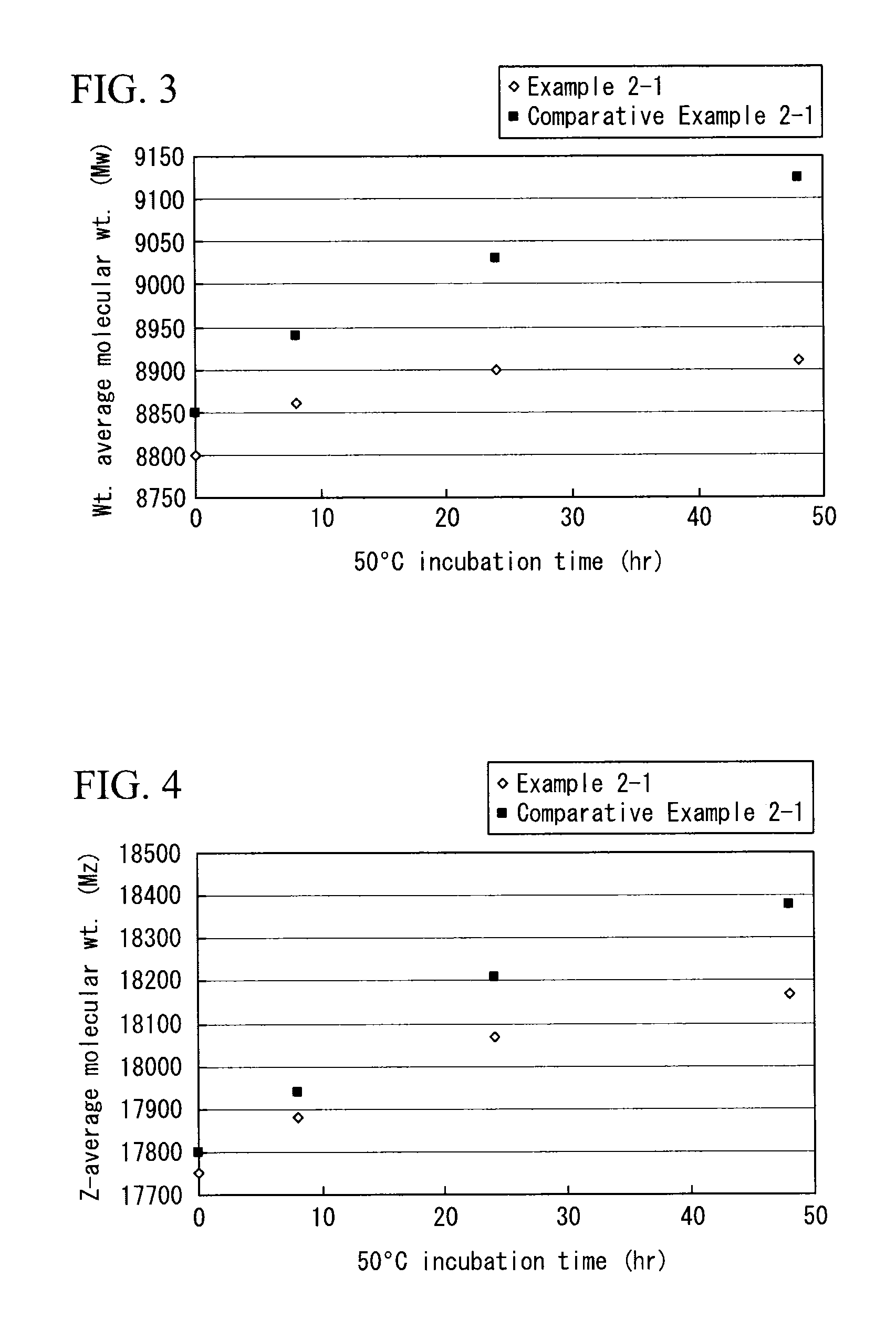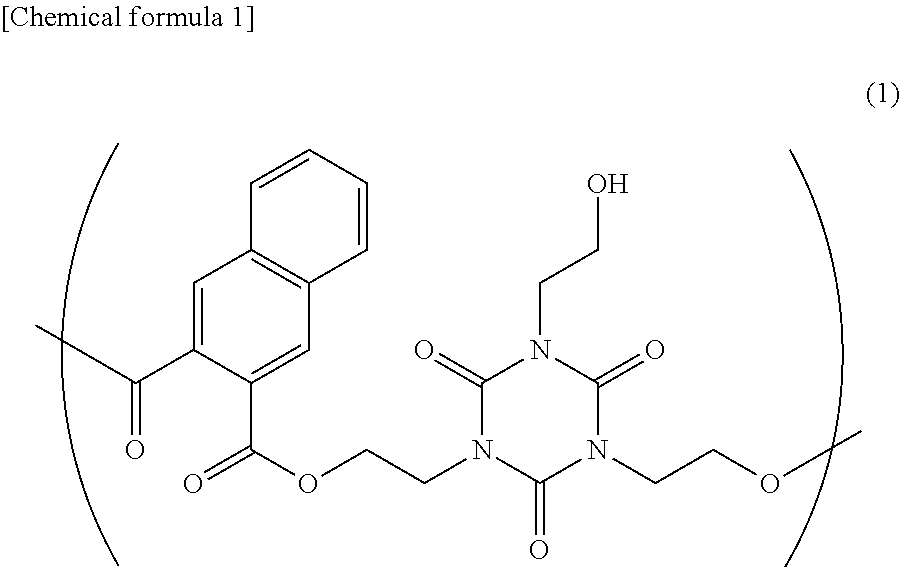Method for producing polymer, and polymer
a polymer and polymer technology, applied in the direction of ion-exchangers, chemical apparatus and processes, chemical/physical processes, etc., can solve the problems of metal contamination during the removal process of plasma, the production yield is reduced, and the product performance of such products is reduced. achieve the effect of reducing the concentration of acidic and basic impurities, high productivity and low cos
- Summary
- Abstract
- Description
- Claims
- Application Information
AI Technical Summary
Benefits of technology
Problems solved by technology
Method used
Image
Examples
synthesis example 1
[0180]First, the following were filled in a three-neck flask: 1,3,5-tris(2-hydroxyethyl)isocyanurate (67.12 grams, 0.258 mol), 2,3-naphthalenedicarboxylic acid dimethyl (63.01 grams, 0.258 mol), p-toluenesulfonic acid hydrate (pTSA) (2.606 grams, 13.7 mmol), and anisole (79.60 grams). Then, the mixture underwent polymerization at 130° C. for 8 hours while dehydration and de-methanol reactions using Dean-Stark trap were carried out. The mixture was cooled to 50° C. and reactions were stopped by adding triethylamine (1.386 grams, 13.7 mmol) (step (a)).
[0181]The polymerized solution was diluted with tetrahydrofuran (THF) (89.4 grams) and a diluted solution was obtained. Then, the diluted solution was added to a mixture (poor solvent) of hexane (580.0 grams) and 2-propanol (IPA) (1740.0 grams), and was reprecipitated (purification through reprecipitation in step (b)). Accordingly, a polyester-based polymer 1 (weight-average molecular weight (Mw): 6300, Z-average molecular weight (Mz): 1...
synthesis example 2
[0182]First, the following were filled in a three-neck flask: 1,3,5-tris(2-hydroxyethyl)isocyanurate (67.12 grams, 0.258 mol), 2,3-naphthalenedicarboxylic acid dimethyl (63.01 grams, 0.258 mol), pTSA (2.606 grams, 13.7 mmol), and anisole (79.60 grams). Then, the mixture underwent polymerization at 130° C. for 8 hours while dehydration and de-methanol reactions using Dean-Stark trap were carried out. Next, the mixture was diluted with THF (89.4 grams), and tetramethoxy glycoluril (TMGU) (25.64 grams, 80.55 mmol) was added to the mixture to carry out reactions at 20° C. for 6 hours. Then, reactions were stopped by adding triethylamine (1.386 grams, 13.7 mmol) (step (a)).
[0183]The polymerized solution was added to a mixture (poor solvent) of hexane (580.0 grams) and IPA (1740.0 grams), and was reprecipitated (purification through reprecipitation in step (b)). Accordingly, a polyester-based polymer 2 (weight-average molecular weight (Mw): 7100, Z-average molecular weight (Mz): 14000, an...
example 1-1
[0184]A mixed resin was prepared using an anion-exchange resin (“Amberlyst B20-HG·Dry” manufactured by Organo Corporation, total exchange capacity of 4.6 mg equivalent / g or greater, moisture content of 10% or less, apparent density of 400 g / L) (33. 25 grams) and a cation-exchange resin (“Amberlyst 15JS-HG·Dry” manufactured by Organo, total exchange capacity of 4.7 mg equivalent / g or greater, moisture content of 2% or less, apparent density of 590 g / L) (1.75 grams). Next, the mixed resin was cleansed with THF and dried. A solution was prepared by dissolving 63.00 grams of polyester-based polymer 1 obtained in Synthesis Example 1 in 147.0 grams of THF, and was added to the dried mixed resin, which was then stirred for 5 hours to remove the acid catalyst (pTSA), the reaction terminator (triethylamine) and metal impurities. After that the mixed resin was removed (step (b)).
[0185]A filter sheet (“CUNO™ Zeta Plus™ filter cartridge EC GN grade”φ 90 mm, manufactured by Sumitomo 3M) was clea...
PUM
| Property | Measurement | Unit |
|---|---|---|
| thickness | aaaaa | aaaaa |
| thickness | aaaaa | aaaaa |
| wavelength | aaaaa | aaaaa |
Abstract
- step (a): producing a polymer in the presence of an acid or base catalyst; and
- step (b): contacting a solution containing the polymer obtained in step (a) to a mixed resin of an anion-exchange resin and a cation-exchange resin.
Description
Claims
Application Information
 Login to View More
Login to View More - R&D
- Intellectual Property
- Life Sciences
- Materials
- Tech Scout
- Unparalleled Data Quality
- Higher Quality Content
- 60% Fewer Hallucinations
Browse by: Latest US Patents, China's latest patents, Technical Efficacy Thesaurus, Application Domain, Technology Topic, Popular Technical Reports.
© 2025 PatSnap. All rights reserved.Legal|Privacy policy|Modern Slavery Act Transparency Statement|Sitemap|About US| Contact US: help@patsnap.com



